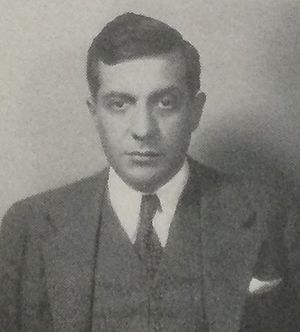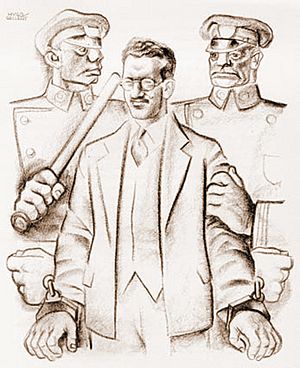Abram Flaxer facts for kids
Quick facts for kids
Abram Flaxer
|
|
|---|---|
| Born |
Abraham Flaxer
September 12, 1904 Vilnius, Lithuania (then, Russian Empire)
|
| Died | January 11, 1989 (aged 84) |
| Nationality | American |
| Known for | Founder of SCMWA, President of UFWA |
| Political party | Communist Party USA |
| Spouse(s) | Victoria White, Charlotte Rosswaag |
Abram Flaxer (1904-1989) was an important American leader for workers' rights. He helped create the State, County, and Municipal Workers of America (SCMWA). This union later joined with the United Federal Workers of America (UFWA). Together, they formed the United Public Workers of America (UPWA), and Abram Flaxer became its president. He spent his life fighting for better conditions for government employees.
Contents
Early Life and Education
Abram Flaxer was born Abraham Flaxer on September 11, 1904. His birthplace was Vilnius, which was part of the Russian Empire at the time. Today, Vilnius is the capital of Lithuania.
Around 1910, his family moved to the United States. They settled in Williamsburg, Brooklyn, a neighborhood in New York City. Abram went to college, studying at the City College of New York. He earned a bachelor's degree there.
He also studied law at New York University Law School, getting his degree in 1932. That same summer, he took math classes at Columbia University.
Career as a Union Leader

Abram Flaxer started his career as a social worker. In the early 1930s, he joined groups that wanted to improve workers' lives. These groups included the Communist Party USA and the Socialist Party of America. He worked alongside other important figures like Mary van Kleeck.
Flaxer taught at a school in the Bronx. He also helped organize unemployed teachers to fight for their rights. He joined the New York City Emergency Relief Bureau (ERB). This organization helped people who were struggling. He became a leader within the ERB.
The ERB grew and changed its name to the Association of Workers in Public Relief Agencies. Flaxer became friends with powerful politicians. These included New York City's Mayor Fiorello La Guardia and Congressman Vito Marcantonio. Flaxer even joined Marcantonio's American Labor Party.
Forming New Unions
Flaxer helped create the American Federation of State, County and Municipal Employees (AFSCME). This union was part of the American Federation of Labor (AFL).
In 1937, Flaxer decided to start a new union. He formed the State, County and Municipal Workers of America (SCMWA). This union joined the Congress of Industrial Organizations (CIO). The SCMWA focused on representing workers in local government jobs.
Abram Flaxer became the national president of SCMWA. He also joined the CIO's main board. He worked with groups like the National Municipal League.
World War II and Challenges
In 1939, Flaxer and the SCMWA took a stand against war. He became a leader in the American Peace Mobilization group.
However, in 1941, his view changed, and he strongly supported the war effort. During this time, some people accused Flaxer of being a member of the Communist Party. By 1941, SCMWA had grown to include 53,000 government employees.
During World War II, there were disagreements within SCMWA. Some members supported the Communist Party, while others did not. The union also faced questions from the government. The House Un-American Activities Committee (HUAC) looked into their activities.
Flaxer believed that government employees should have the right to strike, even during wartime. He said this at a union meeting in 1941. He also wrote about it in a magazine in 1942.
In 1944, a report by the U.S. House of Representatives mentioned Flaxer. It noted his leadership of SCMWA since 1937. It also pointed out his past involvement with the Communist Party. The report listed many groups he had joined. These groups often worked for civil rights and social justice.
Union Mergers and Expulsion
In 1946, SCMWA joined with another union, the UFWA. They formed a new, larger union called the United Public Workers of America (UPWA).
The UPWA openly supported the Soviet Union's foreign policy. This caused many members to leave the union. They joined rival unions like AFSCME instead.
In 1948, the UPWA faced more challenges. A government committee questioned Flaxer. They asked if he was a communist. His lawyers argued that these questions were unfair.
In November 1949, the CIO, a large union organization, held a meeting. They decided that Communist Party members could not hold leadership roles in unions. The CIO then accused 10 unions, including UPWA, of being controlled by communists.
A special committee was set up to investigate UPWA and Flaxer. The UPWA stopped paying its dues to the CIO. They said the committee was biased against them.
On February 16, 1950, the CIO voted to remove UPWA. On March 1, 1950, the CIO officially expelled UPWA. This was part of a larger effort to remove unions thought to be controlled by communists.
Later, people testified that Flaxer had been a Communist Party member. In February 1953, the UPWA union officially closed down.
Fighting for Rights and Legal Challenges

Abram Flaxer stood against government efforts to question people's beliefs. He debated U.S. Representative Richard Nixon on the radio. They discussed a program that checked the loyalty of federal employees.
By 1950, Flaxer himself was accused of being a Communist Party member. In 1951, he appeared before a Senate committee. He refused to share the names of UPWA members. He believed it was wrong to reveal private information.
In 1953, a jury found him guilty of refusing to answer Congress's questions. He was sentenced to jail time and a fine. His lawyers, David Rein and Joseph Forer, helped him appeal the decision.
In 1958, the U.S. Supreme Court heard his case, Flaxer v. United States. The court ruled in Flaxer's favor. This was a big victory for him and for people's rights to privacy.
Personal Life and Death
In June 1928, Abram Flaxer married Victoria White. They were married for ten years. Later, he married Charlotte Rosswaag. Charlotte also worked for the SCMWA union.
Abram Flaxer passed away on January 11, 1989.
Works
Abram Flaxer wrote a memoir, which is like a life story. It was called A View from the Left Field Bleachers, but it was never published.
See also
- Flaxer v. United States, 358 U.S. 147 [1958]
- State, County, and Municipal Workers of America (SCMWA)
- United Federal Workers of America (UFWA)
- United Public Workers of America (UPWA)
- Arthur Stein
- Alfred Bernstein
- Herbert Fuchs
- David Rein
- Joseph Forer


